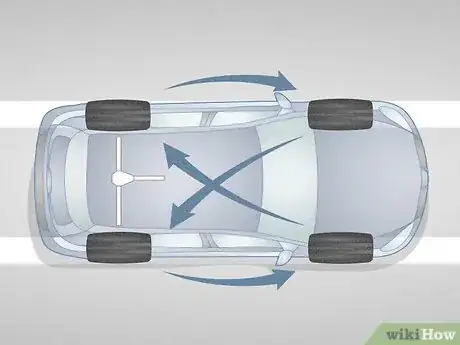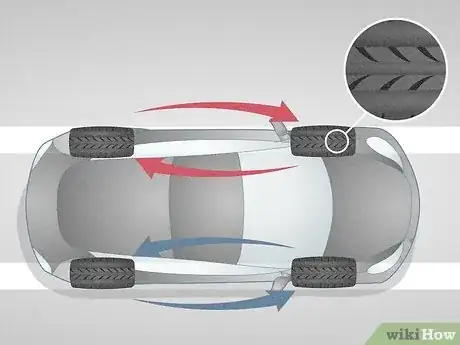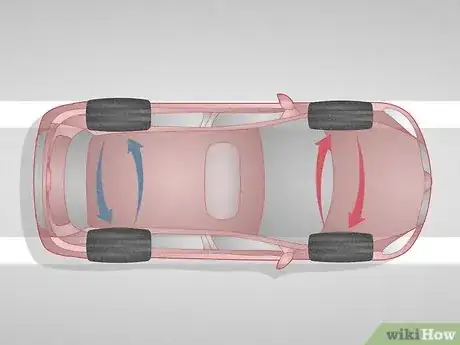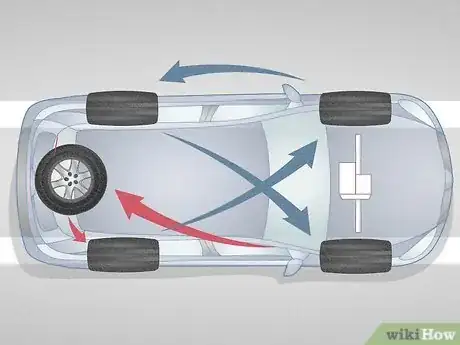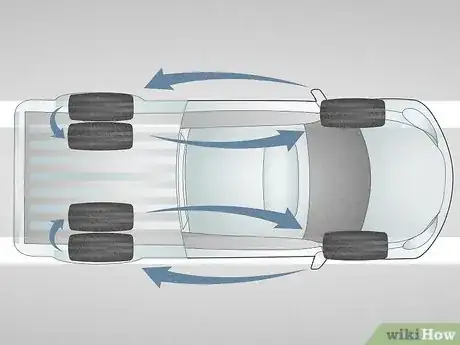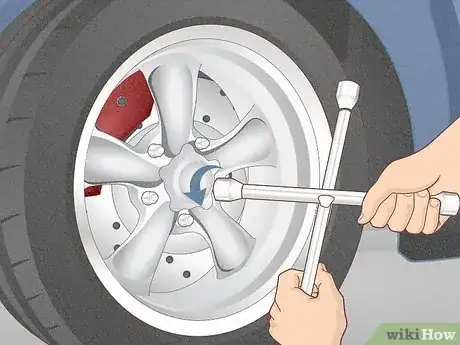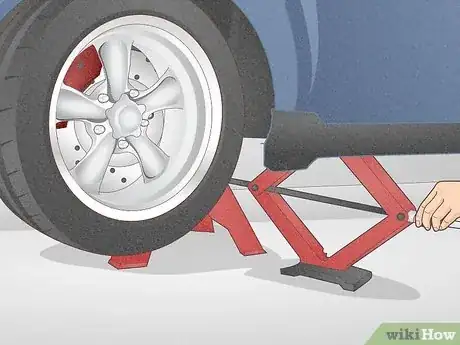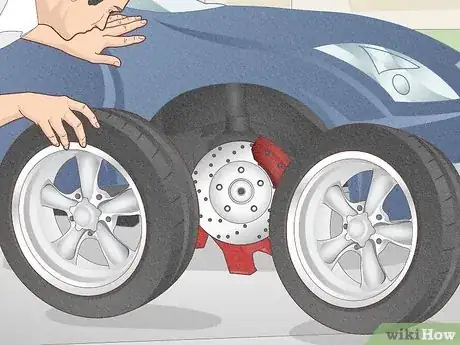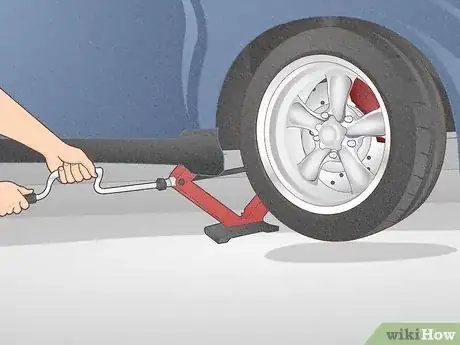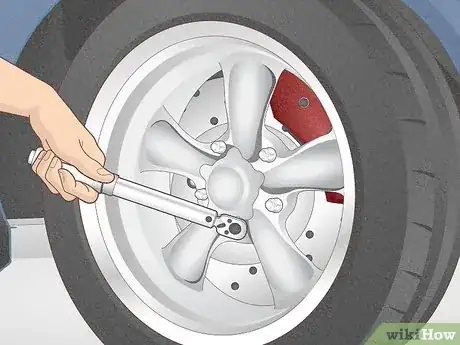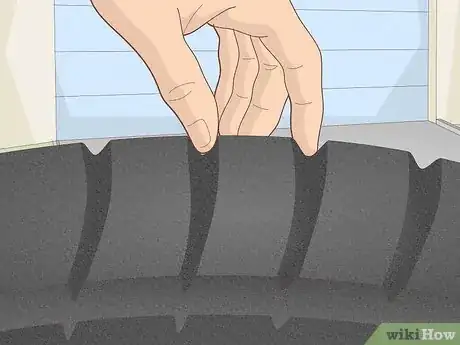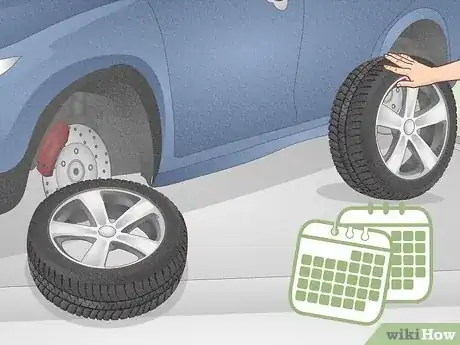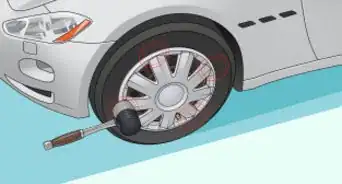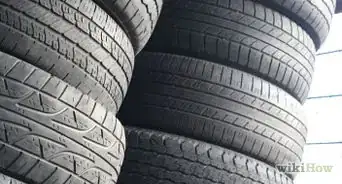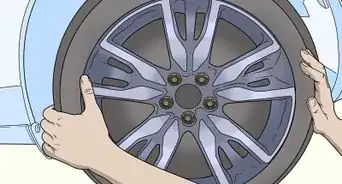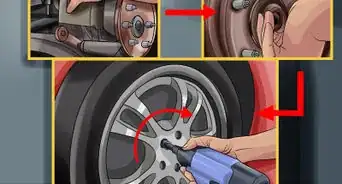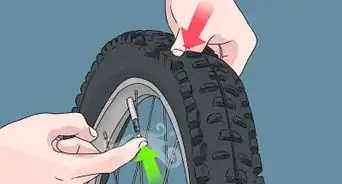This article was co-authored by Rocco Lovetere and by wikiHow staff writer, Hunter Rising. Rocco Lovetere is the Owner and a Master Mechanic at Rocco's Mobile Auto Repair in California. With over 20 years of experience, he specializes in Honda, Acura, Toyota, Nissan, Infiniti, and Volvo cars. He is an ASE Certified Automotive technician and has worked in automotive repair since 1999.
There are 14 references cited in this article, which can be found at the bottom of the page.
This article has been viewed 244,675 times.
If your tires sound noisy or don’t get as much traction as they used to, you may be overdue for a tire rotation. Rotating your tires simply means changing their positions on your vehicle so they wear out evenly. Rather than taking your vehicle to a costly mechanic, you can easily rotate your tires at home with a few tools. Keep reading to learn how to rotate your tires properly and use the correct rotation pattern for your vehicle.
Things You Should Know
- For front wheel drive vehicles, bring the front tires to the back on the same sides. Move the rear tires to the front on the opposite sides.
- For rear wheel drive vehicles, move the rear tires to the front but keep them on the same side. Put the front wheels in the back on opposite sides.
- For all wheel and four wheel drive vehicles, swap the front left with the back right tire, and the front right with the back left tire.
- Rotate your tires every 6 months or 5,000–8,000 miles (8,000–12,900 km).
Steps
Rotating Your Tires at Home
-
1Loosen the lug nuts with a lug wrench. You can get better leverage when you loosen your lug nuts while your vehicle is still on the ground. Park your vehicle on flat, level ground. Turn each of the lug nuts counter-clockwise until they’re looser and easier to turn.[8]
- If the place where you parked isn’t level, block the tires with wheel chocks to keep your vehicle from rolling.
- Don’t remove the lug nuts completely yet since the tires could slip off your vehicle and cause damage.
- If you need to remove a stuck tire, try knocking it loose by tapping a piece of scrap wood against the side of the tire with a hammer.
-
2Jack your car up onto jack stands. Find the jack points under your vehicle, which are usually reinforced metal parts of the frame just behind or in front of your tires. Place a car jack against the frame and lift up your vehicle. Position the jack stands underneath your vehicle's frame, and lower the jack back down. Use a total of 4 jack stands so you have one next to each tire.[9]
- Check your vehicle’s manual to find the proper jack points if you have trouble finding them on your own.
- Avoid trying to rotate your tires while your vehicle is on the jack since it could easily slip off, which could lead to damage or injury.
-
3Remove the lug nuts to take the tires off your vehicle. When you have your vehicle lifted up, use your wrench to finish unscrewing the nuts. Then, just simply pull the tire off your vehicle to remove it.[10]
- Keep the lug nuts in a small bowl so you don’t misplace them.
-
4Move the tires to their new locations following the rotation pattern. Use the appropriate tire pattern for the type of vehicle and tires you have. Just roll the tire to the new position, and carefully slide it straight onto the bolts in the new wheel well.[11]
- When in doubt, check your vehicle’s manual for the proper tire rotation pattern to use.
-
5Screw the lug nuts in until they feel snug. Feed the lug nuts back onto the ends of the bolts and turn them clockwise to tighten them. Turn them as far as you can by hand before using your lug wrench to turn them until they just feel snug.[12]
- Don’t screw the nuts in completely just yet since you could over-tighten them by accident.
-
6Lower your vehicle back to the ground. Slide your jack back underneath your vehicle so it presses against the frame. Lift your vehicle up slightly so you can slide out the jack stands. Then, slowly lower your vehicle back onto the ground.[13]
-
7Finish tightening the lug nuts in a star pattern with a torque wrench. A torque wrench prevents you from over-tightening the nuts and damaging your tires. Adjust your wrench to the proper torque, and turn one of the lug nuts until you hear the wrench click. Find the nut directly across from the first one and tighten it. Then, tighten the nut that’s right next to the first one. Keep working back and forth between the lug nuts until they’re all tight.[14]
- Each vehicle has different torque requirements, so check the manual to know what you need.
References
- ↑ https://youtu.be/DA612MTqjAc?t=29
- ↑ https://www.firestonetire.com/content/dam/bst/PDF/GM_OE_Warranty_EN.pdf
- ↑ https://youtu.be/aNirlIcDD-M?t=215
- ↑ https://irp-cdn.multiscreensite.com/e8c477c1/files/uploaded/Bridgeastone_Tyre_Rotation.pdf
- ↑ https://youtu.be/DA612MTqjAc?t=112
- ↑ https://www.firestonetire.com/content/dam/bst/PDF/GM_OE_Warranty_EN.pdf
- ↑ https://youtu.be/1XX3QPGIWhg?t=12
- ↑ https://youtu.be/u3x6PxFYTK8?t=70
- ↑ https://youtu.be/J-CoaXtT3Go?t=114
- ↑ https://youtu.be/314HE4aMG-g?t=443
- ↑ https://www.firestonetire.com/content/dam/bst/PDF/GM_OE_Warranty_EN.pdf
- ↑ https://youtu.be/u3x6PxFYTK8?t=177
- ↑ https://youtu.be/314HE4aMG-g?t=672
- ↑ https://www.shorelandr.com/PDF_Docs/07-Wheel-Assembly-Chart-REV-B.pdf
- ↑ https://youtu.be/ng2qpBKliNw?t=81
- ↑ https://www.themechanicdoctor.com/five-ways-maintain-vehicle-for-long-life/
About This Article
Rotating your tires can help them last longer and wear out evenly. To get started, first engage the emergency break to ensure your vehicle doesn't slide around. Then, remove the hubcaps and loosen the bolts on each tire without removing them completely. Next, use a jack to lift one side of your vehicle off of the ground so it's high enough to slide 2 jack stands underneath. Repeat this process on the other side to raise your vehicle completely off of the ground. Check the pattern on your tires to find out if they're directional or non-directional. If the grooves on your tires lead out away from the center of your vehicle, they are directional, which means that they need to stay on the same side when you rotate them. In that case, loosen the nuts all the way and swap the driver’s side front tire with the driver’s side rear tire. Do the same thing on the opposite side of your vehicle. If the grooves on your tires are uniform and don’t lead away from the center, that means your tires are non-directional. In that case, remove all of the tires. Put the driver’s side front tire on the rear of the passenger’s side. Move the passenger’s side front tire to the back of the driver’s side. Then, take the rear tires on each side and put them on the front of the same side. Either way, screw the bolts part way back in after you rotate the tires. Use a jack to brace your vehice and slide the jack stands out. Do this on both sides, then tighten the bolts all the way with your vehicle on the ground. Finally, replace the hubcaps. Depending on your make and model, your tires should be rotated every 3,000-5,000 miles. For more tips from our Mechanic co-author, like how to remove your tires, scroll down!

